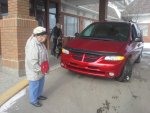Good reminder to pay attention to our own driving (because it's not us we need to worry about, it's the other people, right?), and well done 98G on the evasive maneuvers to avoid becoming directly involved in the collision, and letting him live to learn something from this.
Another reminder we can take away from this is a little lesson on vehicle dynamics.
Your tires have a certain amount of traction given the coefficient of friction for the rubber compound and the surface it's in contact with, along with the size of the contact patch and the weight on the patch. When you steer, brake, or accelerate, the weight of the vehicle will shift away from the direction of force applied to the vehicle (steer left, weight transfers right, brake and weight transfers forwards).
The above is important to remember if you find yourself in a situation where a tire or two leave the pavement. The coefficient of friction for dirt, grass, or gravel is about and order of magnitude less than that of pavement. If you make a rapid steering input to steer away from the shoulder of the road, your weight will transfer away from the steering input meaning that your vehicle's weight will transfer to the tire(s) with the least traction.
In performance driving, there is a concept of "
the circle of traction" - which is to say that for any given tire patch, coefficient of friction, and weight on the patch you will have a certain sized circle which represents your available traction or adhesive limit. If you apply force against that circle you must stay within the boundaries of that circle to retain grip on the road - go outside the circle and you start sliding.
If you turn sharply while tires are on a low traction surface, your circle gets much smaller, so you need to impart smaller forces to your vehicle controls to remain in traction and control of the vehicle's path. This means that if you put a tire or two off the pavement at speed you need to slowly correct your line to get back on the road - this could result is you going off the road completely first. Remember that if you also panic and release your foot from the accelerator pedal, the weight will transfer forwards meaning there is less grip on your rear tires, so if you make a rapid steering input the rear tires are more likely to step out (oversteer/spin-out).
The key is to not panic if you screw up, think it through, and understand what the vehicle is doing and telling you. If you need to swerve to avoid something on pavement, give the maximum circle of traction to each step of your swerve. Brake first to transfer weight forwards, release the brakes and steer away from the hazard, straighten out and brake again to retransfer the weight forwards, then steer to grab the next lane (so you don't run off the road) straightened out again and then brake to a stop. It seems like a lot of work and steps, but realize the alternative is sliding into something/someone, or rolling over.
Even for you guys with ABS trucks, you should still learn
threshold braking, the point of maximum braking force before the tires start to slip/scrub - this is even before ABS kicks in when the wheels stop spinning from being locked up. You need to know how far you can push your brakes.
I'd rather know what the vehicle CAN DO, than have my vehicle protect me from what it can't do. It's my opinion that the modern safety systems are quickly relieving the interest and concern of the driver to the hazards and responsibilities of driving...



